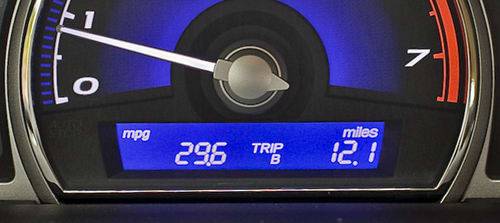Cars.com Hybrid Mileage Challenge: Part 5


In Cars.com’s latest Mileage Challenge, we relied mostly on each car’s onboard mileage readout, a feature integrated into the trip computer on many cars these days. Ultimately we chose to use the readouts over our own at-the-pump calculations. In our final installment, we’ve decided to look at just how those readouts work — and more specifically, how accurate they are compared to calculations made at the pump.
Experts were split: Some defended the onboard displays as significantly more accurate than at-the-pump calculations. Another said that the differences tend to even out over time, while another warned that mileage readouts have their own set of potential inaccuracies.
So what makes these things tick?
Generally speaking, they’re able to gauge instantaneous and cumulative mileage by factoring vehicle speed against how much gas your fuel injectors squirt into the engine. Most run on standardized calibrations, which produce “pretty repeatable and accurate” results, GM’s Terry Connolly said. Connolly is director of the automaker’s North American Energy Center.
The systems aren’t always airtight. Ford technology spokeswoman Jennifer LaForce noted that changes in fuel density, which can vary depending on where you fill up, can affect accuracy, as can tire wear or wheel size. As vehicles age, fuel injectors can get dirty, but LaForce and Connolly said even if that happens, internal sensors will keep accurate tabs on the amount of fuel passing through. It’s all part of a “closed-loop” system, Connolly said.
How do these systems compare to more traditional mileage calculations — specifically, pumping a dozen-plus gallons and doing some quick division before you reset the odometer? Honda spokesman Jon Fitzsimmons said such methods can yield varying results because of fuel pump inaccuracies. Connolly echoed the sentiment: “Pumps have widely varying flow rates, which affects nozzle shutoff substantially,” he said. “The difference in fill levels by a half-gallon is not unusual at all.”
At-the-pump calculations can be especially dicey if you’ve only filled up with a few gallons, University of West Virginia’s James Smith said. Smith teaches mechanical and aerospace engineering at the school, and he’s also the Society of Automotive Engineers’ 2009 president-elect. At the end of a fill-up, gas pumps click off because an internal sensor tells them there’s enough backpressure in your tank that it’s full, Smith said. As such, their accuracy can vary: “They weren’t made to be accurate, they were made to be safe,” he said.
That doesn’t mean you should top off your tank at every stop, but it does suggest a potential for variance. “When you’re looking at the pump, say it says 14 gallons, you could be off a half of a 10th either way,” Smith said. But if you’re only putting in a few gallons, that difference could amount to 5% or 10%.
A litany of other variables, from the design of the gas tank and filler tube to the outside temperature and density of the fuel, can also interfere with fill-up accuracy. You can even affect the point at which the pump clicks off by how you insert the nozzle into your tank, Smith said.
All told, this gives plenty of reason to trust in-car mpg readouts over calculations at the pump in the short run, but it doesn’t mean at-the-pump calculations are worthless: Over several weeks and multiple tanks of gas, the variations should even out, and you should get pretty comparable numbers, Smith said. He regularly calculates mileage in his Ford Explorer, both at the pump and through the trip computer’s mileage readout.
Ford’s LaForce agreed.
“Generally, the value should be pretty close, but there are variables,” she said. “The best method is to check gallons consumed and distance traveled over two to three fill-ups to estimate your mpg, and to crosscheck against the [onboard mileage] meter.”

Former Assistant Managing Editor-News Kelsey Mays likes quality, reliability, safety and practicality. But he also likes a fair price.
Featured stories



